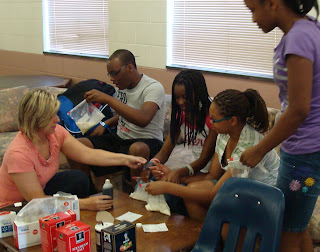MHC After 3 campers investigated science and engineering concepts with VMNH educators this summer. Camps were held at the group's site or off-site at a local state park. The camps were designed based on student input gathered during the spring semester.
In the Projectile Science camp, campers explored the engineering design process and Newton's 1st and 3rd laws of motion through several design challenges using common household items. Students designed and constructed marshmallow launchers, medieval counterweight trebuchets, and balloon rockets to explore the forces that affect projectiles.
In the Food Engineering and Package Design camp, participants investigated food science engineering by creating ice cream and granola. Campers explored several examples of packaging and were challenged to design the best package to store their food products. Each package was tested to discover the most effective design.
The Trail Design camp explored the process and effects of erosion through designing trails with erosion prevention in mind. In teams, they designed small model trails, tested whether they were "erosion proof" and then redesigned the model to reduce erosion. They evaluated the hiking trails at Fairy Stone State Park to examine trail design and evidence of erosion. They also explored the effects of erosion on water bodies, including a stream and lake. Finally, they worked together to repair existing trails using erosion prevention methods.


















































